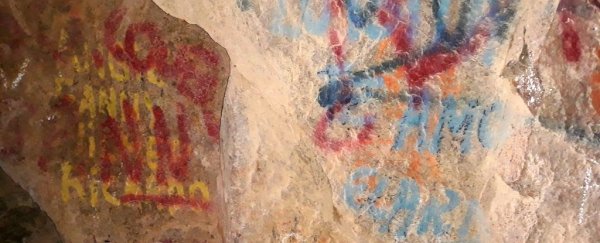If you wanted to feel irrationally angry today, look no further than the Anzota Caves in Chile, where late last month it was discovered that ancient cave paintings were heavily damaged by graffiti.
Worse, the authorities have explained that although the graffiti isn't recent, nothing has been done to secure the area or to try and minimise the damage.
The Cuevas de Anzota, south of the city of Arica, is a series of caves inhabited by indigenous people in the pre-Columbian times. Now the graffiti has covered the ancient drawings of animals and vessels typical of the region.
It appears that the vandalised area was never actually open to the public, but other parts of the caves and mountain have recently been through a restoration project to increase tourism, and have been open to the public since the 1960s.
According to Spanish newspaper EL PAÍS, the poster outside the cave warns "Archaeological Site preserved for future study and enhancement" in Spanish.
Chilean musician Felipe Sandoval shared the images on Twitter in late February.
Indignante. Las pinturas rupestre de los camélidos, pertenecientes a la cultura Tiwanaku en las Cuevas de Anzota, Arica (600 d.C aprox.) fueron rayadas con pintura en aerosol. Un daño irreparable a nuestro patrimonio.
— Felipe Sandoval (@SanFelipeDoval) February 27, 2018
¿Hasta cuándo? pic.twitter.com/y2LycsWWIW
The tweet says that irreparable damage has taken place, and finishes with a question roughly translated to "how long?". According to authorities, the answer is "a while".
As EL PAÍS reports, the Minister of Public Works said that the graffiti on the art wasn't new, but it hasn't been cleaned as a cautionary measure.
As University of Tarapaca archaeologist Marcela Sepúlveda explains, any intervention to clean the panel will also damage it.
And it looks like that's not the only issue with the area - some of the replies to Sandoval's tweet paint an even grimmer picture, with the comments acknowledging garbage being left throughout the site and the caves smelling like urine.
But there might be a silver lining, as Sepúlveda hopes that with the awareness from this damage, the governments might be forced to improve the care and security of Cuevas de Anzota, along with other important historical sites.
Here's hoping.
